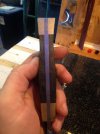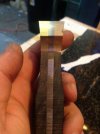- Joined
- Sep 10, 2011
- Messages
- 350
I finished my second knife a couple days ago and I noticed that when I sanded the handle material down to be flush with the sides of the tang there are what looks like air spaces or pockets of epoxy between the flat of the tang and the flat of the handle material. What is this caused by? Not clamping hard enough while the epoxy is drying? Are my flats not perfectly flat enough causing pockets of additional epoxy to build up?
I will post pictures tonight.
I will post pictures tonight.


